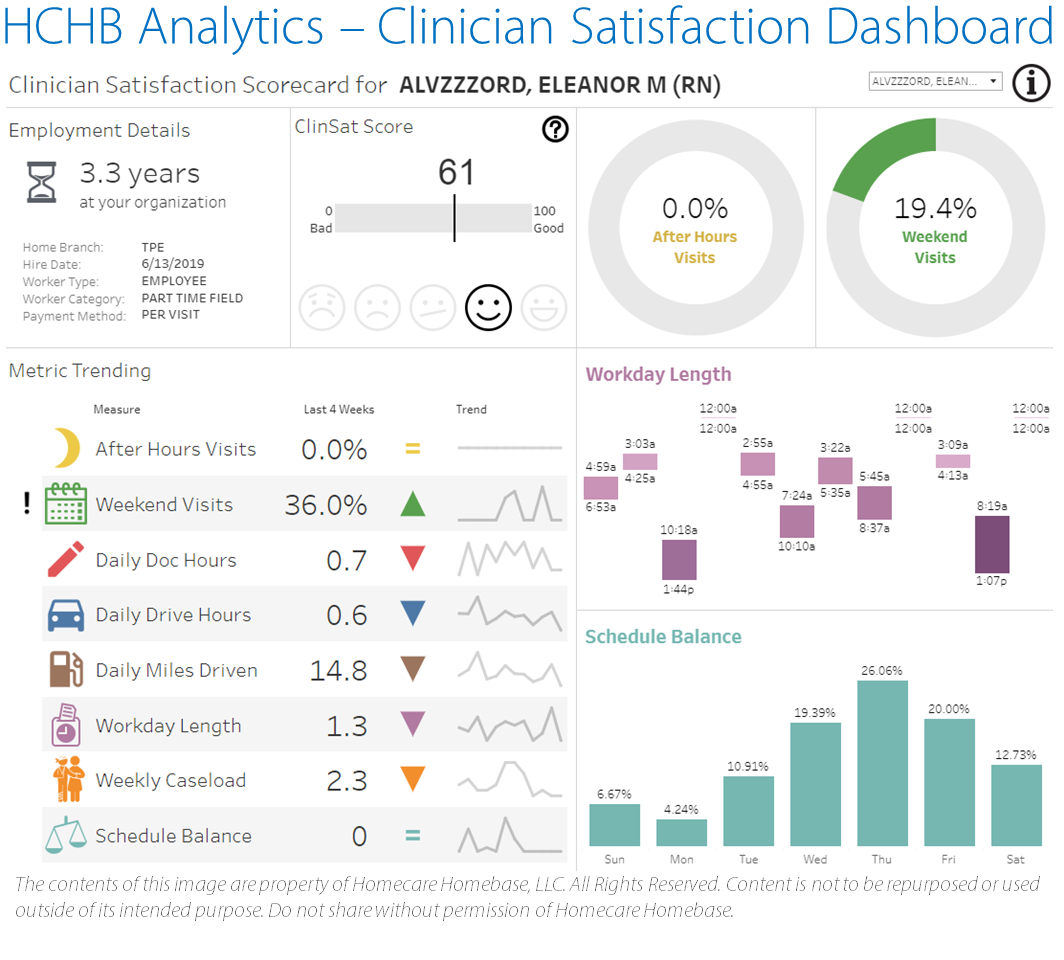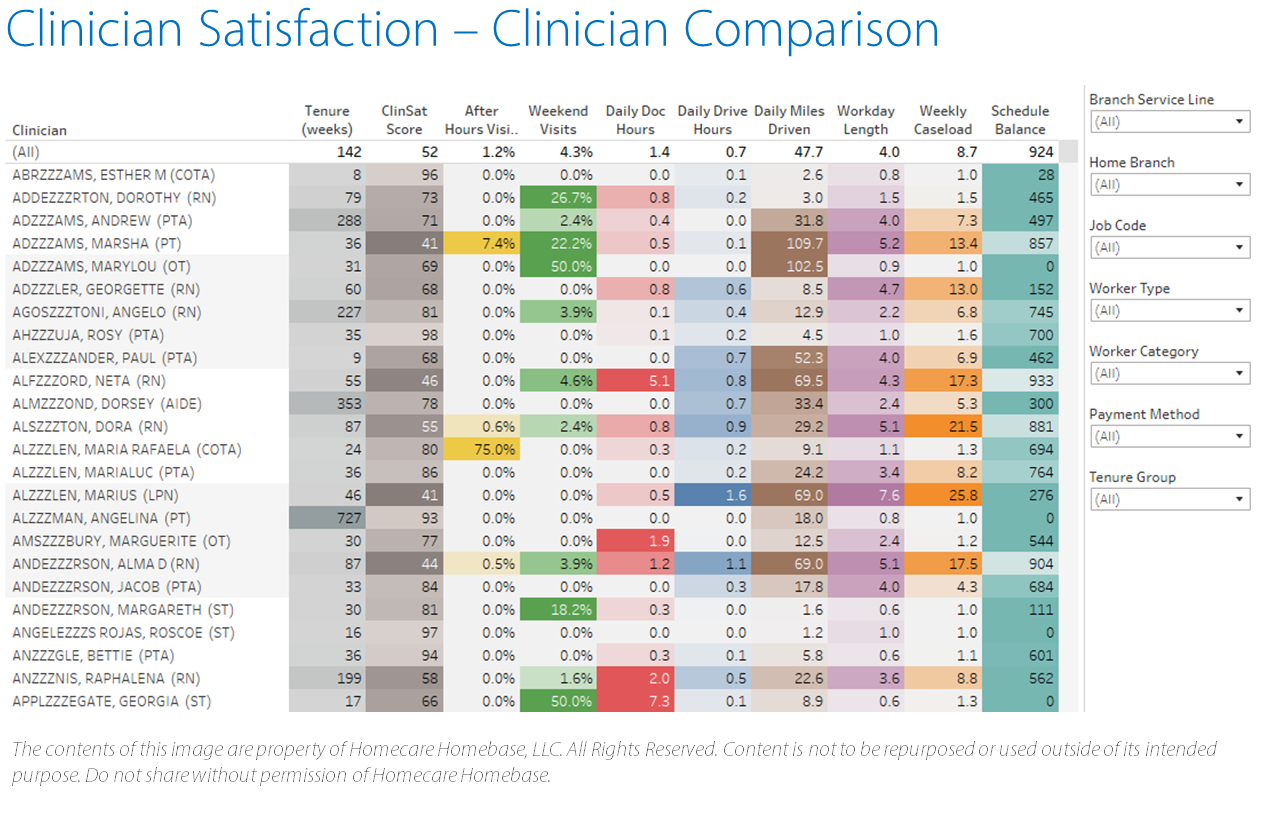How a Clinician Dashboard Creates an Engaged Workforce
Rethinking the Clinician Experience: 3 Leadership Questions
- Do you have insight into clinician job satisfaction and a way to identify the potential for burnout in real time?
- Can you examine key factors that contribute to job satisfaction, performance, and retention?
- How can you find opportunities to improve clinical satisfaction and retention?
In this special report, we provide guidance to help your organization improve the clinician experience and gather data to easily track satisfaction and achieve a more engaged workforce.
Top 8 Key Dimensions of Clinician Satisfaction
The first step is to identify the factors impacting clinician satisfaction. Homecare Homebase found eight metrics that contribute to clinical satisfaction through correlation analysis.
- After hours visits: Percentage of visits between 6pm and 6am.
- Weekend visits: Percentage of visits on Saturday or Sunday.
- Daily documentation hours: Average time the clinician is spending on documentation outside of their visits.
- Daily driving time: Average hours spent driving to visits each day.
- Daily miles driven: Average mileage driving to visits each day.
- Workday length: Average hours between first and last visits each day.
- Weekly caseload: Average number of patients visited each week.
- Schedule balance: Distribution of visits across work week. For example: are the visits spread out across the entire work week or does the clinician have a heavy schedule Friday and Saturday and very few visits on other days?
The ability to access all these eight dimensions within a single, easy-to-read dashboard allows your organization to gauge job satisfaction and performance and jump-start conversations to engage with your workforce.
1. Analyze from a Scorecard Perspective
Get a holistic view of a single clinician’s experience by viewing all of their key satisfaction metrics in a single view. HCHB Analytics’ Clinician Satisfaction Scorecard allows you to evaluate where a clinician may be struggling and start a conversation with them to ensure they are happy or talk through ways the agency can help improve their experience.

2. Look for Trends Across Your Clinicians
Analyze how a clinician’s metrics compare to other clinical staff members in the organization. Are there difficulties with an outlier that can be solved with training? Are you seeing struggles with one of the metrics across board? If multiple clinicians are struggling with the same metric, this may be an indication that a process improvement or additional tool may be needed to improve satisfaction. It is also important to compare clinician satisfaction from branch to branch.

- What metrics you should track to gauge clinician satisfaction.
- Tips for analyzing clinician satisfaction data on company-wide, branch, and clinician levels.
- How to engage your staff to move the needle on retention.
WEBINAR: USING ANALYTICS TO TACKLE CLINICIAN SATISFACTION
How to Find Opportunities to Improve Clinical Satisfaction and Retention
The Challenge to Find, Hire, and Keep Top Talent has Never Been Tougher
The challenge to find, hire, and keep top talent has never been tougher. Home health clinician turnover rates remain high. Most clinical turnover takes place within 6-18 months, so it is important to pay close attention to satisfaction scores for new employees and consider ways to improve your onboarding and retention strategies. How can your organization find opportunities for improvement?
One example is to start by looking at factors that could be impacting clinicians’ overall satisfaction scores within their first two years of employment at the branch level, as well as reviewing at-risk clinicians individually.
- How much time is being spent outside of the home documenting?
- What are the hiring practices and the expectations as outlined in clinician contracts?
- How much time is actually being spent with patients?
Or think about clinician burnout as it pertains to your organization.
- What did I hire this clinician to do and during what hours?
- What does “after hours” mean at my organization?
- How am I scheduling clinicians for visits?
Scheduling Factors are Key Drivers of Clinician Satisfaction
In Home Health Care, Staffing Continues to be the Most Critical Pain Point
Consider these two questions in connection to staff satisfaction and retention.
- Is your organization optimizing staff utilization? Staff members appreciate being able to practice at the top of their license, lending their training and skills to patients who need them the most.
- Is your organization providing consistent continuity of care? Patients and caregivers alike prefer relationships that engender trust. Staff satisfaction is increased because they can build closer relationships with patients that they see multiple times. Continuity of care increases both patient and caregiver satisfaction, which is a win/win for your organization.
Technology companies are stepping up to help agencies address complex scheduling needs. Homecare Homebase launched its HCHB Smart Scheduling tool to ease back-office burdens on busy schedulers. Scott Decker, HCHB’s CEO, noted “Smart Scheduling works directly to tackle one of the industry’s most arduous, time-consuming tasks that often requires several resources and typically creates inefficient schedules. Both drive up costs and keep clinicians from spending quality time with the patients best matched to their skillset.”
Get information about putting the right people in the right places for exceptional care.
How to Use Clinician Dashboards as a Management Tool
The home health industry is changing so quickly that leadership can no longer rely solely on their instincts and experience to improve clinician satisfaction and retention. Clinical management resources offer key metrics to fully engage your workforce and scorecards open conversations. Rethinking the clinical experience can position your organization as an engaged leadership team that listens to the voice of your clinicians.

Brandy Sparkman-Beierle, RN, is the Chief Clinical Officer at Homecare Homebase. With 17+ years in clinical operations, change management, and process improvement, Brandy leverages her expertise to help create customized solutions for agencies nationwide. Her specialties include business development, care redesign, and outcomes improvement to help HCHB customers streamline processes, maximize internal resources, and spend more time on exceptional patient care. Brandy shared some insights on using the clinician satisfaction dashboard.
Question: How should management use the clinician satisfaction dashboard?
If the clinician is showing red in the dashboard, that’s an indication to have a conversation and ask, “How are you doing”? People want to be appreciated. This tool gives a big picture view of their day and helps you ask some great probing questions like “How do you feel about your weekend schedule?” “Do you feel your schedule is balanced?” “Is there any aspect of your work that could cause care fatigue?” It’s a good check-in for a leader and gives you a good idea of the drivers that you’re doing well. It also gives you a sense of direction to start peeling back the layers and find areas that you need to focus on to truly make an impact.
Question: You’ve stated that clinician dashboards are an important tool for engaging in productive conversations with clinicians. Why are these conversations around satisfaction so important?
Clinicians have become more vocal and assertive in recent times, demanding that their perspectives and concerns be heard and addressed. Clinicians are a key stakeholder in the healthcare industry and their feedback is crucial for improving patient care and ensuring the well-being of healthcare professionals. Care fatigue is a real issue affecting many clinicians today. While some may use the term “burnout” to describe this phenomenon, I believe that “fatigue” is a more appropriate term as it acknowledges the many factors that can contribute to this state, including long hours, high stress, and challenging work conditions. It is important to listen to and address the concerns of clinicians to improve healthcare delivery. By recognizing the challenges facing clinicians and working to address these issues, healthcare organizations can help to ensure that clinicians are able to provide high-quality care to their patients while also maintaining their own physical and mental health.
Question: What can healthcare technology companies do to address clinician satisfaction?
Healthcare technology companies can choose to place a strong emphasis on incorporating feedback from clinicians into the design and development of their applications. Companies should actively listen to the perspectives and insights of clinicians and incorporate this feedback into the design process to ensure that applications meet the needs of healthcare professionals. By placing the clinical perspective at the forefront of its design process, Homecare Homebase is aiming to create more effective and user-friendly applications that support clinical work flows and enhance patient care. This approach enhances clinician satisfaction, as it shows that our company values and respects their input and expertise.
Homecare Homebase is a Dallas-based software leader offering hosted, cloud-based solutions to streamline operations, simplify compliance and boost clinical and financial outcomes for home-based care agencies. Our customized mobile solutions enable real-time, wireless data exchange and communication between eld clinicians, physicians and office staff for better care, more accurate reporting, and improved revenue cycle management. Founded by industry veterans in 1999, HCHB empowers over 200,000 users to service more than 800,000 patients daily, resulting in over one hundred million visits per year. Visit them at hchb.com.










